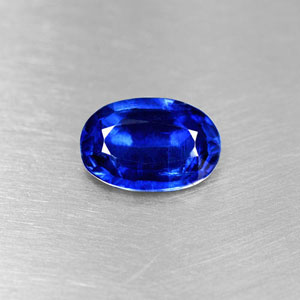Kyanite
Starting at Rs. ₹100.00 Per Rati
Named after the greek word ‘kyanos’, after its brilliant deep blue colourKyanite also appears in colorless, white, gray, green, orange or yellow.
The physical as well as chemical properties of Kyanite vary with its environmental conditions.
The benefits of Kyanite are:
– Kyanite inflicts loyalty and stability relationships
– helps working through disagreements and disputes
– aids in mending damaged relationships
– helps in settling disputes
– enhances communication skills
– cuts off self destructive behaviour
Description
Kyanite stone is a gemstone quality aluminum silicate sometimes referred to as disthene, rhaeticite or cyanite. Its name is derived from the Greek word ‘kuanos’ or ‘kyanos’, which means ‘deep blue’, alluding to its typical blue color. However, in addition to blue, kyanite can also be colorless, white, gray, green, orange or yellow. With kyanite stone, color is typically not consistent throughout. In fact, most stones exhibit areas of light to dark color zones, along with white streaks or blotches. Kyanite is a polymorph of both andalusite and sillimanite. Polymorph gemstones share similar chemical compositions, but they exhibit different crystal structures. Kyanite stone forms as triclinic crystals, while andalusite and sillimanite are both orthorhombic.
Kyanite’s most distinctive trait is its strong anisotropic properties. Most gems are anisotropic to some extent, but kyanite stone is the most famous of anisotropic gemstones. Anisotropic gemstones exhibit varying properties, depending on their crystallographic direction. When kyanitez stone is cut parallel to its long axis, its hardness can range from 4 to 4.5 on the Mohs scale, but when cut perpendicularly, its hardness can range from 6 to 7.
Kyanite stone is a member of the aluminosilicate series and exhibits a distinctive property known as anisotropism. Kyanite can be very easily identified by its dual hardness. Many materials exhibit variable hardness on different crystal faces, but kyanite’s variable hardness can be seen in the very same crystal. As a result of its distinct dual hardness and its frequent habit of color streaking and blotching, kyanite stone can be very easy to identify from other gems.
Kyanite stone deposits can be found in many locations around the world. Some of the most important sources include Austria, Burma, Brazil, Cambodia, India, Kenya, Myanmar, Nepal, Russia, Serbia, Switzerland, Tanzania, the United States (Connecticut, Pennsylvania, North Carolina and Georgia) and Zimbabwe.
Orange kyanite stone was recently discovered in Tanzania. Large teal crystals have also recently been found in Kenya’s Umba Valley. Nepal is now widely regarded as one of the finest kyanite sources. Nepalese kyanite is said to rival the blue color of fine Ceylon and Madagascar sapphire.
Kyanite deposits can be found in many locations around the world. Some of the most important sources include Austria, Burma, Brazil, Cambodia, India, Kenya, Myanmar, Nepal, Russia, Serbia, Switzerland, Tanzania, the United States (Connecticut, Pennsylvania, North Carolina and Georgia) and Zimbabwe.
Orange kyanite was recently discovered in Tanzania. Large teal crystals have also recently been found in Kenya’s Umba Valley. Nepal is now widely regarded as one of the finest kyanite sources. Nepalese kyanite is said to rival the blue color of fine Ceylon and Madagascar sapphire.
Kyanite can be transparent to translucent. Transparent specimens are most desirable. Almost all kyanite stones will exhibit some visible flaws. Color zoning is often mistaken for internal inclusions. Kyanite stones of over 2 carats are considered rare. Kyanite looks best in daylight and exhibits a vitreous to near-pearly luster when cut and polished.
Transparent kyanite is typically faceted, whilst translucent materials are most often cut en cabochon. Cat’s eye kyanite cabochons are also available. When cutting, proper orientation is essential since kyanite’s hardness is directly associated with its cut. The most common shapes include ovals and pears as they preserve the most weight. Fancier shapes are rarer and may demand higher premiums, such as rounds, hearts and trillions, particularly when cut into calibrated sizes.
Kyanite inspires loyalty and fair treatment to others. It assists in working through disagreements and disputes, and can aid in repairing damaged relationships. It is beneficial in negotiations, diplomatic missions, arbitration and other forms of communication between disharmonious people, allowing disparate energies to move into resonance and find a common frequency.
In the workplace, Kyanite promotes good communication, bridging the gap between different beliefs and ideas, and encourages self-expression and speaking one’s truth. Hold or wear Kyanite when addressing a group, or leading a seminar or team meeting. It sharpens communication skills, and is particularly helpful when answering questions or when there is a need to improvise.
For those who have lost their way in life, or are trying to break a cycle of self-destructive behavior, use Kyanite in an empowerment grid to get back on track. Lay out rows of small Kyanite blades radiating from a central Kyanite in six different directions. Use each night to walk a different path in the mind, letting images and ideas take form spontaneously. Continue until you no longer need the grid.
To access forgotten childhood memories or to recall a word or name that eludes you, touch the center of your brow with Kyanite. For children who have trouble integrating with others, or are physically different in any way, keep Kyanite blades near their outdoor or school clothing to help increase their popularity. Black Kyanite, with its grounding energies, supports environmental healing, connecting with those who are pulling pollution out of the earth and assisting the evolution of the planet.


Reviews
There are no reviews yet.